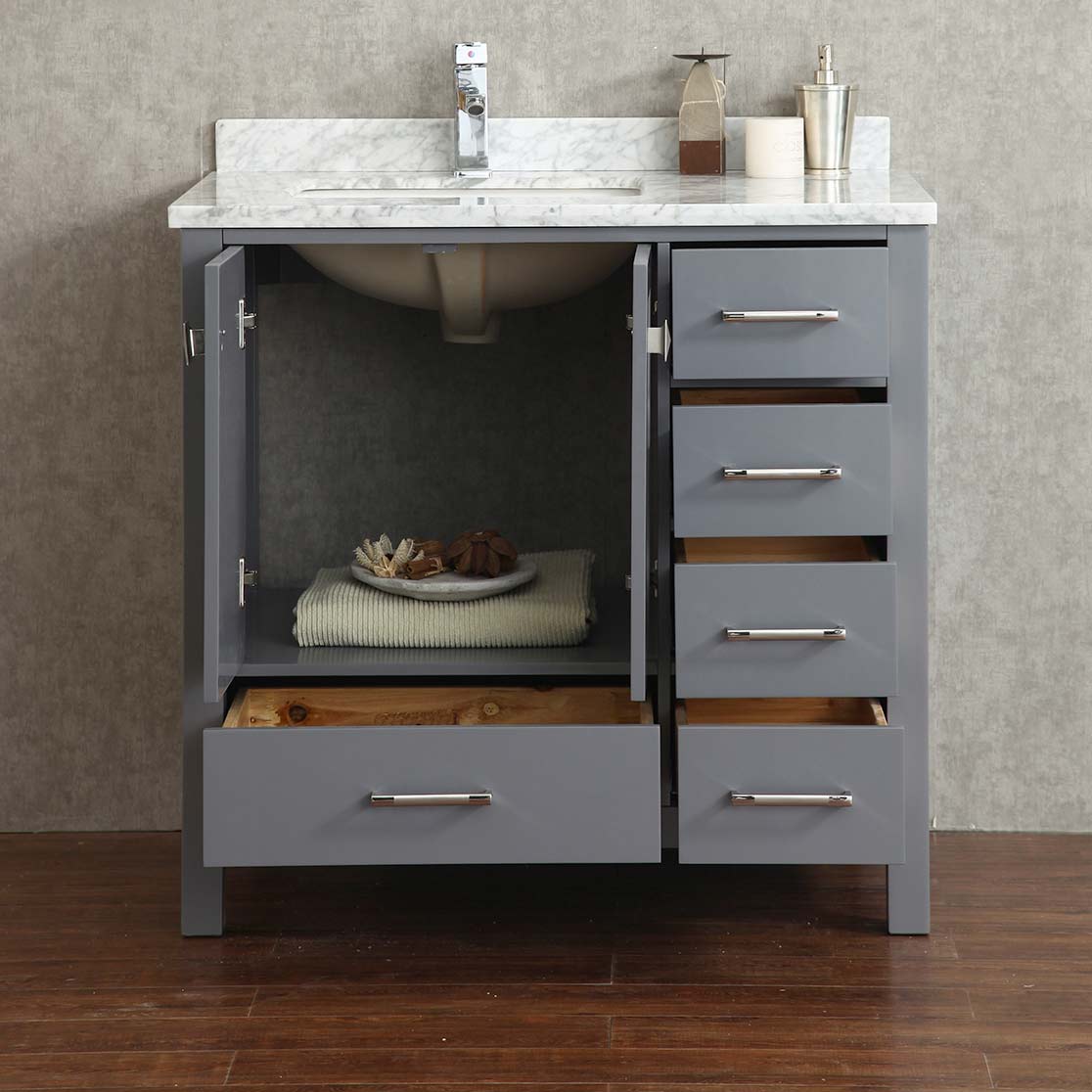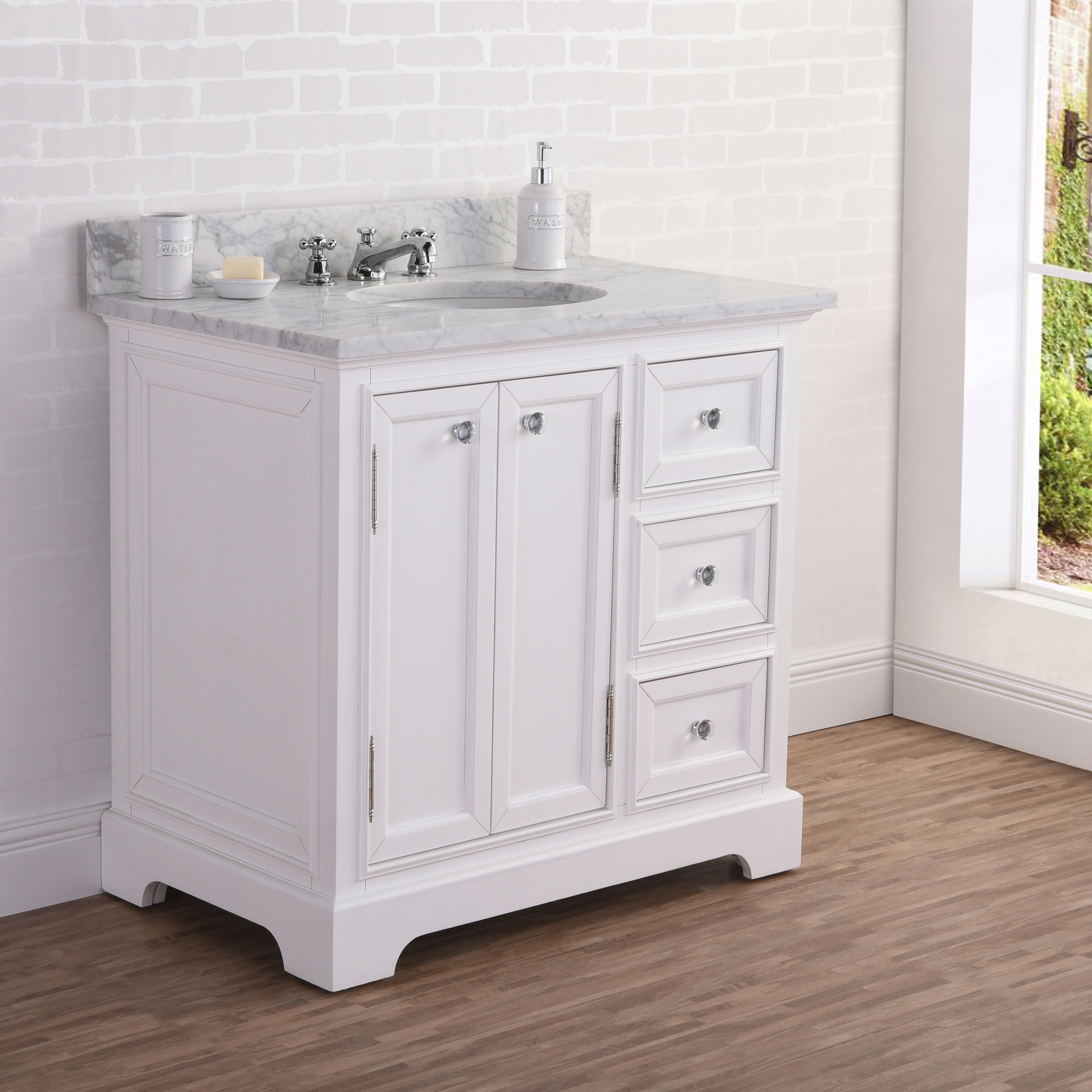Understanding the Freestanding 36 Inch Bathroom Vanity

A freestanding bathroom vanity is a stylish and functional piece of furniture that offers a distinct aesthetic and practical advantages over traditional wall-mounted vanities. It is a standalone unit, typically featuring a countertop, cabinets, and a sink, designed to be placed independently within the bathroom space. Freestanding vanities are increasingly popular in modern bathroom design due to their versatility, visual appeal, and ability to enhance the overall ambiance of the room.
Benefits and Drawbacks of Freestanding Vanities
The choice between a freestanding and a wall-mounted vanity depends on individual preferences and bathroom layout considerations. Freestanding vanities offer several benefits, including:
- Enhanced Design Flexibility: Freestanding vanities can be placed anywhere in the bathroom, allowing for creative arrangements and the ability to adapt to various room shapes and sizes.
- Improved Aesthetics: They can be a focal point of the bathroom, adding a touch of elegance and sophistication. Their freestanding nature allows for more design freedom, with various styles, materials, and finishes available.
- Increased Storage Space: Freestanding vanities often feature larger cabinets and drawers, providing ample storage for bathroom essentials.
However, there are also some drawbacks to consider:
- Limited Space Flexibility: Freestanding vanities require more floor space than wall-mounted options, which can be a constraint in smaller bathrooms.
- Installation Complexity: Installing a freestanding vanity might require more effort and time compared to a wall-mounted unit, especially if plumbing connections need to be adjusted.
- Potential for Movement: While freestanding vanities are generally sturdy, they can be susceptible to movement, particularly on uneven floors, which could lead to instability or damage.
Features and Functionalities of a 36 Inch Freestanding Vanity
A 36-inch freestanding vanity is a popular choice for smaller bathrooms or for those who prefer a more compact design. It typically features:
- Countertop: The countertop is usually made of durable materials like marble, granite, quartz, or laminate, providing a smooth and easy-to-clean surface.
- Sink: The sink can be integrated into the countertop or placed on top of it. It can be a single-bowl or double-bowl sink, depending on the vanity’s design.
- Cabinets: The vanity cabinets provide storage space for towels, toiletries, and other bathroom necessities. They can have doors, drawers, or a combination of both, offering various storage options.
- Hardware: The hardware, including knobs, handles, and hinges, can be chosen to complement the vanity’s style and enhance its overall aesthetic appeal.
- Mirror: A mirror is often included as part of the vanity set, although it can also be purchased separately. It enhances the bathroom’s functionality and provides a decorative element.
Materials Used in Freestanding Vanity Construction
Freestanding vanities are available in a wide range of materials, each offering unique characteristics and aesthetic appeal:
- Wood: Wood is a classic and versatile material for vanity construction. It is known for its durability, warmth, and natural beauty. Common wood types used for vanities include oak, maple, cherry, and walnut. Wood vanities can be stained or painted to achieve a desired finish.
- Marble: Marble is a luxurious and elegant material often used for countertops and vanity tops. It is known for its distinctive veining patterns and timeless appeal. Marble is a durable material, but it is susceptible to etching from acidic substances, so proper care and maintenance are essential.
- Granite: Granite is another popular choice for countertops, known for its durability, scratch resistance, and heat resistance. It comes in various colors and patterns, offering a wide range of design options. Granite is a non-porous material, making it relatively easy to clean and maintain.
- Quartz: Quartz is an engineered stone made from crushed quartz crystals and resin. It is known for its durability, stain resistance, and low maintenance requirements. Quartz is available in a wide range of colors and patterns, offering a modern and sophisticated look.
- Acrylic: Acrylic is a synthetic material often used for vanities due to its affordability, durability, and easy maintenance. It is available in a range of colors and finishes, offering a variety of design options. Acrylic vanities are typically lightweight and easy to install.
Design and Functionality

Freestanding 36-inch bathroom vanities offer a blend of style and practicality, providing ample storage and a focal point for your bathroom design. Their freestanding nature allows for flexibility in placement, making them ideal for both traditional and modern bathroom layouts.
Design Styles
Freestanding 36-inch vanities are available in a wide range of design styles to complement any bathroom aesthetic.
- Contemporary: These vanities feature clean lines, minimalist designs, and often incorporate materials like metal, glass, and high-gloss finishes. They often have a sleek and modern look, perfect for contemporary bathrooms.
- Traditional: Traditional vanities exude elegance and sophistication. They typically feature ornate details, carved wood, and classic hardware. They are ideal for creating a timeless and luxurious bathroom atmosphere.
- Rustic: Rustic vanities bring a touch of nature indoors. They often use reclaimed wood, natural stone, and distressed finishes. These vanities create a warm and inviting atmosphere, perfect for farmhouse or cottage-style bathrooms.
Key Design Elements
Several key design elements contribute to the functionality of a freestanding vanity:
- Storage Options: Freestanding vanities offer various storage solutions, including drawers, cabinets, and open shelves. Drawers are ideal for storing smaller items, while cabinets provide ample space for larger items. Open shelves offer easy access to frequently used items.
- Countertop Materials: The countertop material is a significant design element, affecting both the aesthetic and functionality of the vanity. Common countertop materials include:
- Granite: Durable, heat-resistant, and scratch-resistant, granite offers a natural, elegant look. It is available in a wide range of colors and patterns.
- Quartz: Engineered quartz is a durable, non-porous material that is stain-resistant and easy to clean. It is available in a wide range of colors and patterns, mimicking natural stone.
- Marble: Known for its luxurious appearance, marble is a soft stone that requires careful maintenance. It is susceptible to scratches and stains but adds a touch of elegance to any bathroom.
- Laminate: Laminate is a cost-effective option that is durable and easy to maintain. It comes in various colors and patterns, offering a wide range of design choices.
- Sink Configurations: Freestanding vanities can accommodate various sink configurations, including single-bowl, double-bowl, and vessel sinks. The choice of sink configuration depends on your bathroom size and personal preferences.
Countertop Materials
Here’s a table showcasing various countertop materials used for freestanding vanities, including their pros and cons:
| Material | Pros | Cons |
|---|---|---|
| Granite | Durable, heat-resistant, scratch-resistant, natural beauty, wide range of colors and patterns | Porous, requires sealing, can be expensive |
| Quartz | Durable, non-porous, stain-resistant, easy to clean, wide range of colors and patterns | Can be expensive, may feel cold to the touch |
| Marble | Luxurious appearance, unique veining, adds elegance | Soft, susceptible to scratches and stains, requires regular maintenance, can be expensive |
| Laminate | Cost-effective, durable, easy to maintain, wide range of colors and patterns | Not as luxurious as natural stone, can be prone to scratches and chips |
Integrated Storage Solutions
Freestanding 36 inch bathroom vanity – Imagine a freestanding vanity with integrated storage solutions, maximizing space and functionality. The vanity features a spacious countertop with a single-bowl undermount sink, providing ample space for daily routines. Below the countertop, a large drawer offers ample storage for toiletries, towels, and other bathroom essentials. The drawer is equipped with soft-close slides for a smooth and quiet operation. Adjacent to the drawer, two cabinets provide additional storage space for larger items like hairdryers, styling tools, and cleaning supplies. The cabinets are equipped with adjustable shelves, allowing for flexible organization. To maximize accessibility, the vanity includes open shelves on the side, perfect for displaying decorative items or storing frequently used items.
Installation and Considerations

Installing a freestanding 36-inch bathroom vanity involves several steps, requiring careful planning and attention to detail to ensure proper functionality and stability. This section will Artikel the key aspects of installation, including plumbing connections, stability, and essential tools and materials. Additionally, it will discuss the importance of ventilation and moisture control in relation to freestanding vanities and provide practical tips for selecting the right size and style for a specific bathroom space.
Plumbing Connections
Connecting the freestanding vanity to the plumbing system is a crucial step. It requires careful planning and execution to ensure proper water supply and drainage.
- Water Supply: Connect the vanity’s water supply lines to the existing water supply pipes in the bathroom. Use appropriate fittings and ensure the connections are secure and leak-free.
- Drainage: Connect the vanity’s drain pipe to the existing bathroom drain system. Ensure the drain pipe is properly sloped to allow for efficient water flow and prevent clogging. Use a P-trap to prevent sewer gases from entering the bathroom.
- Testing: After connecting the water supply and drain lines, test the vanity for leaks. Run water through the faucet and check for any leaks at the connections.
Stability
Ensuring the stability of a freestanding vanity is essential for its longevity and safety.
- Leveling: Use a level to ensure the vanity is perfectly level before securing it to the floor. This will prevent the vanity from tilting or wobbling.
- Anchoring: Secure the vanity to the floor using appropriate anchors or brackets. This will provide additional stability and prevent the vanity from moving or shifting.
- Weight Distribution: Distribute the weight of the vanity evenly by placing heavy items in the center of the countertop. Avoid placing heavy objects on the edges of the countertop, which could cause the vanity to become unstable.
Tools and Materials, Freestanding 36 inch bathroom vanity
Installing a freestanding vanity requires specific tools and materials.
- Tools: A level, measuring tape, drill, screwdriver, wrench, plumber’s tape, and pipe cutters.
- Materials: Anchors, brackets, plumbing fittings, drain pipe, P-trap, sealant, and silicone caulk.
Ventilation and Moisture Control
Proper ventilation and moisture control are essential for maintaining the integrity and longevity of a freestanding vanity.
- Ventilation: Ensure adequate ventilation in the bathroom to prevent moisture buildup. Install an exhaust fan to remove excess moisture from the air.
- Moisture Control: Use a sealant to prevent water from seeping into the vanity’s wood or other materials. Regularly clean and dry the vanity to prevent moisture buildup.
Choosing the Right Size and Style
Selecting the right size and style of freestanding vanity is crucial for maximizing functionality and aesthetics in a bathroom.
- Size: Measure the available space in the bathroom carefully before selecting a vanity. Consider the width, depth, and height of the vanity to ensure it fits comfortably and allows for adequate movement.
- Style: Choose a vanity style that complements the overall design of the bathroom. Consider the materials, finishes, and design elements of the vanity to create a cohesive look.
A freestanding 36-inch bathroom vanity offers ample storage and a classic look, but if space is a concern, consider a more compact option. A 24 inch corner bathroom vanity can maximize your bathroom’s potential, fitting snugly into an often-unused corner.
While a freestanding 36-inch vanity provides a statement piece, a corner vanity can be the perfect solution for smaller bathrooms.
A freestanding 36-inch bathroom vanity offers a compact and stylish solution for smaller bathrooms. If you have a larger space, however, you might consider a more expansive option like a 76-inch bathroom vanity. These larger vanities provide ample storage and countertop space, making them ideal for families or those who prefer a more luxurious bathroom experience.
Regardless of your choice, a freestanding vanity can add a touch of elegance and sophistication to any bathroom.